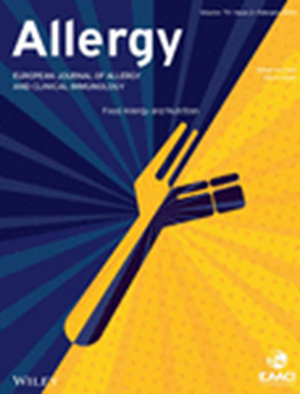Transcriptomic Analysis of Allergic Patch Test Reactions in Non-Atopic Patients: A Comparative Study Across Multiple Allergens.
IF 12.6
1区 医学
Q1 ALLERGY
引用次数: 0
Abstract
BACKGROUND Immune mechanisms underlying elicitation in allergic contact dermatitis (ACD) have yet to be fully elucidated. Previous studies have shown a double-faceted nature of ACD with both common biomarkers among different allergens and allergen-specific imprinting, albeit with discordance in terms of relevant pathways involved. Several factors, including co-existing atopic dermatitis, may influence immune reactions. We aim to characterize molecular signatures and their immune mechanisms of different relevant allergens (nickel, 2-hydroxyethylmethacrylate [2-HEMA], methylisothiazolinone [MIT], formaldehyde) in strong and extreme positive (2/3+) patch test reactions of patients without atopic dermatitis. METHODS A transcriptomic analysis of 40 skin biopsies of ACD reactions (11 nickel, 10 MIT, 10 2-HEMA, 9 formaldehyde) and 19 controls (petrolatum-occluded skin) was performed using RNA sequencing. Differentially expressed genes (DEG) were assessed, and enriched functional pathways were obtained with an over-representation analysis for allergens. RESULTS ACD molecular profiling revealed a strong, common imprinting of DEG among allergens versus controls (n = 814), with further partially shared DEG among allergens (n = 664) and allergen-specific DEG (n = 430). The most relevant shared pathways were associated with immune adaptive and innate responses. All allergens exhibited mixed effector immune responses, mainly type 1 and 3 immunity, and, to a lesser extent, type 2 immunity. Furthermore, partially shared and unique DEG were associated with further inflammatory pathways, particularly for nickel and 2-HEMA. CONCLUSIONS This study confirms shared ACD imprinting among different allergens and shared pathways' predominant role in ACD elicitation in patients without atopic dermatitis, alongside allergen-specific immune processes and mixed effector responses (type 1, 3 and 2).非特应性患者过敏斑贴试验反应的转录组学分析:跨多种过敏原的比较研究。
背景:过敏性接触性皮炎(ACD)诱发的免疫机制尚未完全阐明。先前的研究表明,ACD具有双重性质,在不同的过敏原和过敏原特异性印记中都有共同的生物标志物,尽管在相关途径方面存在不一致。包括共存的特应性皮炎在内的几个因素可能影响免疫反应。我们的目的是表征不同相关过敏原(镍、2-羟乙基甲基丙烯酸酯[2-HEMA]、甲基异噻唑啉酮[MIT]、甲醛)在非特应性皮炎患者强烈和极端阳性(2/3+)斑贴试验反应中的分子特征及其免疫机制。方法采用RNA测序对40例ACD反应皮肤活检(11例镍、10例MIT、10例2-HEMA、9例甲醛)和19例对照(凡士油闭塞皮肤)进行转录组学分析。对差异表达基因(DEG)进行了评估,并通过对过敏原的过度代表性分析获得了丰富的功能途径。结果sacd分子图谱显示,过敏原与对照组(n = 814)之间的DEG存在强烈的共同印记,过敏原(n = 664)和过敏原特异性DEG (n = 430)之间的DEG存在部分共享。最相关的共享通路与免疫适应性和先天反应有关。所有过敏原均表现出混合效应免疫反应,主要是1型和3型免疫反应,其次是2型免疫反应。此外,部分共享和独特的DEG与进一步的炎症途径相关,特别是镍和2-HEMA。结论:本研究证实,在非特应性皮炎患者中,不同过敏原之间存在共同的ACD印记,在ACD引发过程中存在共同的通路,以及过敏原特异性免疫过程和混合效应反应(1型、3型和2型)。
本文章由计算机程序翻译,如有差异,请以英文原文为准。
求助全文
约1分钟内获得全文
求助全文
来源期刊

Allergy
医学-过敏
CiteScore
26.10
自引率
9.70%
发文量
393
审稿时长
2 months
期刊介绍:
Allergy is an international and multidisciplinary journal that aims to advance, impact, and communicate all aspects of the discipline of Allergy/Immunology. It publishes original articles, reviews, position papers, guidelines, editorials, news and commentaries, letters to the editors, and correspondences. The journal accepts articles based on their scientific merit and quality.
Allergy seeks to maintain contact between basic and clinical Allergy/Immunology and encourages contributions from contributors and readers from all countries. In addition to its publication, Allergy also provides abstracting and indexing information. Some of the databases that include Allergy abstracts are Abstracts on Hygiene & Communicable Disease, Academic Search Alumni Edition, AgBiotech News & Information, AGRICOLA Database, Biological Abstracts, PubMed Dietary Supplement Subset, and Global Health, among others.
 求助内容:
求助内容: 应助结果提醒方式:
应助结果提醒方式:


